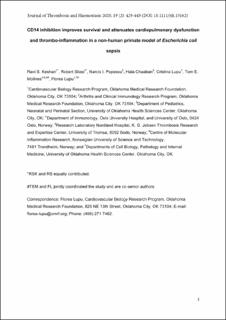| dc.description.abstract | Background
During sepsis, gram‐negative bacteria induce robust inflammation primarily via lipopolysacharride (LPS) signaling through TLR4, a process that involves the glycosylphosphatidylinositol (GPI)‐anchored receptor CD14 transferring LPS to the Toll‐like receptor 4/myeloid differentiation factor 2 (TLR4/MD‐2) complex. Sepsis also triggers the onset of disseminated intravascular coagulation and consumptive coagulopathy.
Objectives
We investigated the effect of CD14 blockade on sepsis‐induced coagulopathy, inflammation, organ dysfunction, and mortality.
Methods
We used a baboon model of lethal Escherichia (E) coli sepsis to study two experimental groups (n = 5): (a) E coli challenge; (b) E coli challenge plus anti‐CD14 (23G4) inhibitory antibody administered as an intravenous bolus 30 minutes before the E coli.
Results
Following anti‐CD14 treatment, two animals reached the 7‐day end‐point survivor criteria, while three animals had a significantly prolonged survival as compared to the non‐treated animals that developed multiple organ failure and died within 30 hours. Anti‐CD14 reduced the activation of coagulation through inhibition of tissue factor‐dependent pathway, especially in the survivors, and enhanced the fibrinolysis due to strong inhibition of plasminogen activator inhibitor 1. The treatment prevented the robust complement activation induced by E coli, as shown by significantly decreased C3b, C5a, and sC5b‐9. Vital signs, organ function biomarkers, bacteria clearance, and leukocyte and fibrinogen consumption were all improved at varying levels. Anti‐CD14 reduced neutrophil activation, cell death, LPS levels, and pro‐inflammatory cytokines (tumor necrosis factor, interleukin (IL)‐6, IL‐1β, IL‐8, interferon gamma, monocyte chemoattractant protein‐1), more significantly in the survivors than non‐surviving animals.
Conclusions
Our results highlight the crosstalk between coagulation/fibrinolysis, inflammation, and complement systems and suggest a protective role of anti‐CD14 treatment in E coli sepsis. | en_US |
